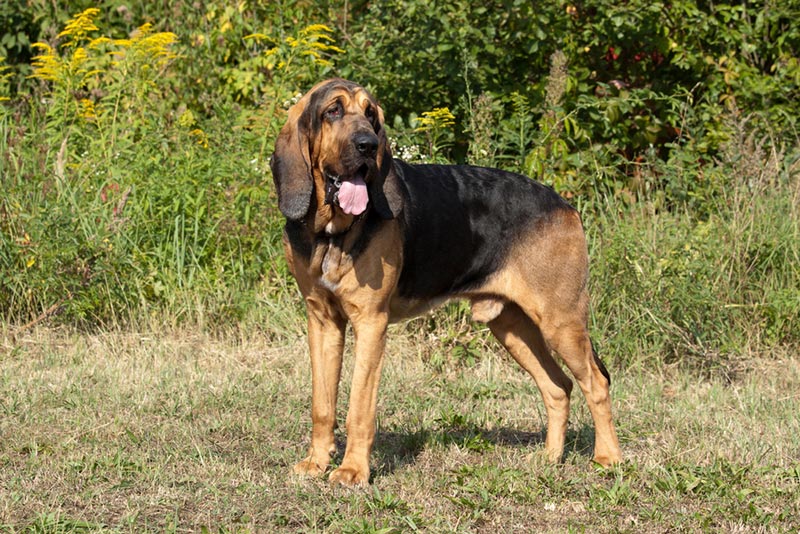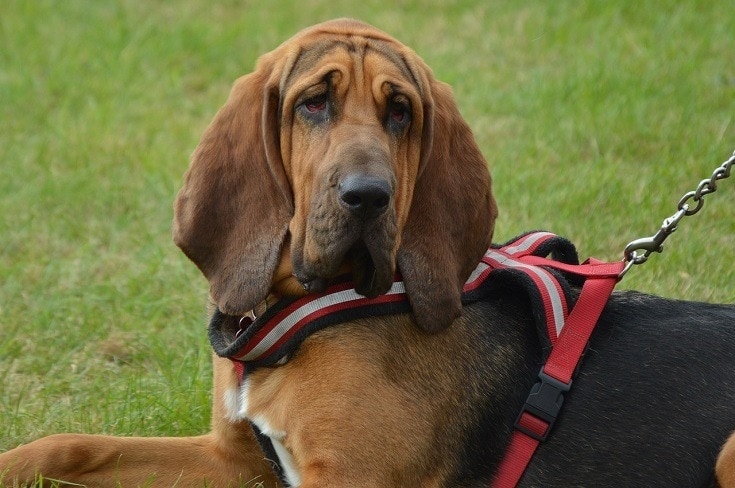Male vs Female Bloodhound: The Differences (With Pictures)
By Jordyn Alger
Updated on

Click to Skip Ahead
Bloodhounds are beloved, popular dogs easily recognized by their drooping faces and long ears. This affectionate dog is frequently brought into households to be a loving companion, and regardless of their sex, many families are more than happy with their affectionate, slobbery friend.
While the most notable differences between male and female Bloodhounds are related to physical attributes such as their sizes, there are some reported differences in personality, as minor as they may be. If you are trying to decide whether a male or female is suitable for your home, the chances are that both sexes would be perfect, but it is still good to know about the nuances of each.
Visual Differences

At a Glance
- Average height (adult): 25–27 inches
- Average weight (adult): 90–110 pounds
- Average height (adult): 23–25 inches
- Average weight (adult): 80–100 pounds
Bloodhound 101
Bloodhounds are large dogs with easily recognizable features, such as their facial wrinkles, droopy ears, and sad eyes. They are most commonly seen with a black and tan coloration but can also have liver and tan or red coats. Many people describe the Bloodhound as having a dignified expression.
These endearing physical qualities make the Bloodhound highly appealing to many people, but the real catch is the Bloodhound’s remarkable disposition. The dog is friendly, charming, and docile, making it an excellent family pet. They are affectionate with their families and have tremendous patience for young children and other, more excitable dogs. As sweet as this breed is, the Bloodhound is also known to have a stubborn streak, making it a challenge to train. However, once you can convince your Bloodhound to engage in training with you, they are eager to please and highly biddable.
Whether you choose a male or a female Bloodhound, you will have an incredible companion. Still, if you are curious about the slight differences between the sexes, we’ll discuss that next.
Male Bloodhound Overview

Personality / Character
The stubborn streak that all Bloodhounds are capable of is more pronounced in the male. Male Bloodhounds can sometimes be defiant, assured that their way is the right way. However, with an experienced and devoted trainer, he can become obedient and well-behaved. Additionally, the male Bloodhound is exceedingly loyal and may want to spend most of his time by your side.
Training
The male Bloodhound can be a bit headstrong, which can make training difficult. Likewise, his attention span may not be as great as the female’s, and he may be prone to tracking random scents he picks up rather than listening to your instructions. However, most Bloodhounds are eager to please, so once he decides that training is worthwhile, he will likely be eager to participate.
Health & Care
Bloodhounds are moderately active and have a 10 to 12-year lifespan. If your male Bloodhound is not neutered, he may be compelled to wander from the home, which could increase the risk of injury if he is attacked by another animal or hit by a car. Some health issues that your Bloodhound may deal with include bloat and hip dysplasia, which are common in larger dogs. Due to the shape of your Bloodhound’s ears, he may also be at risk of an ear infection.
- Ear infections
- Hip dysplasia
- Bloat

Breeding
If you plan on breeding your Bloodhound, make sure that you are prepared to cover all expenses for needed resources and care. Breeding is an expensive venture that requires a high standard of ethics and care. When it comes to breeding with a male Bloodhound, the task is usually easier, as those who own the male usually do not need to monitor the female’s pregnancy.
- Social
- Self-assured
- Self-dependent
- Defiant
- More often destructive
Female Bloodhound Overview

Personality / Character
Typically, the female Bloodhound is a soothing, calming presence. She is patient and caring, always willing to tolerate younger children or other, more rowdy dogs. Although she can be strong-willed at times, as can any Bloodhound, she is usually more agreeable than the male and will be quick to follow through with commands.
Training
Female Bloodhounds are better at focusing on the task at hand when compared to males. Her ability to cast aside other distractions in favor of following through with the commands given to her makes her easier to train than the male. However, she can still be stubborn at times, so it takes a competent and dedicated trainer to get through to her.
Health & Care
Like the male, there are some health concerns associated with unfixed females. Spayed dogs are less likely to develop severe conditions such as fatal uterine infections and certain cancers. The health conditions that the female is at risk for are similar to those of the male.
- Ear infections
- Hip dysplasia
- Bloat

Breeding
Breeding a female Bloodhound is more expensive than breeding a male, and it requires more dedication and effort. Caring for a pregnant female requires a lot of time, resources, and energy, so it is not a task to take lightly. Likewise, you will need to care for the puppies after they are born, so it is essential that you can cover all of the costs of caring for your animals.
- Gentle
- Adaptable
- Eager to please
- Somewhat clingy
- Can be more expensive
Which Gender Is Right for You?
For the most part, there are not many significant differences between the male and the female Bloodhound. There are slight nuances to personality that may be noticed, but in broad strokes, the sexes are fairly similar. In reality, your dog’s individual personality is more likely to have an effect on their disposition than their sex. Still, considering the sex of your dog can be an important step in deciding which dog is right for you, as it may help you understand which dog would better suit your lifestyle.
Featured Image Credit: (L) Lenkadan, Shutterstock | (R) Degtyaryov Andrey, Shutterstock













